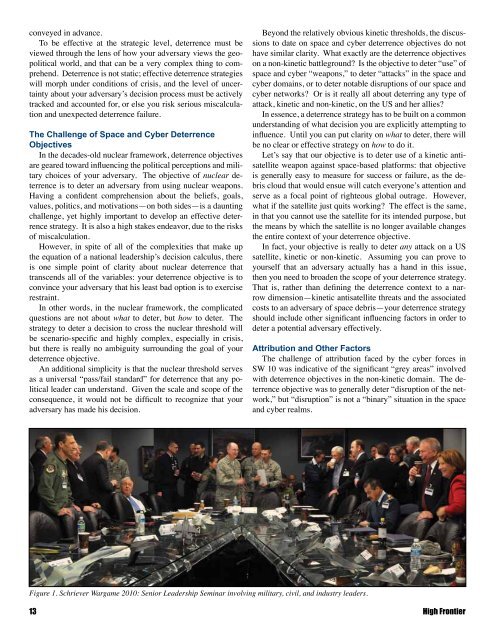Schriever Wargame 2010 - Air Force Space Command
Schriever Wargame 2010 - Air Force Space Command
Schriever Wargame 2010 - Air Force Space Command
Create successful ePaper yourself
Turn your PDF publications into a flip-book with our unique Google optimized e-Paper software.
conveyed in advance.<br />
To be effective at the strategic level, deterrence must be<br />
viewed through the lens of how your adversary views the geopolitical<br />
world, and that can be a very complex thing to comprehend.<br />
Deterrence is not static; effective deterrence strategies<br />
will morph under conditions of crisis, and the level of uncertainty<br />
about your adversary’s decision process must be actively<br />
tracked and accounted for, or else you risk serious miscalculation<br />
and unexpected deterrence failure.<br />
The Challenge of <strong>Space</strong> and Cyber Deterrence<br />
Objectives<br />
In the decades-old nuclear framework, deterrence objectives<br />
are geared toward influencing the political perceptions and military<br />
choices of your adversary. The objective of nuclear deterrence<br />
is to deter an adversary from using nuclear weapons.<br />
Having a confident comprehension about the beliefs, goals,<br />
values, politics, and motivations—on both sides—is a daunting<br />
challenge, yet highly important to develop an effective deterrence<br />
strategy. It is also a high stakes endeavor, due to the risks<br />
of miscalculation.<br />
However, in spite of all of the complexities that make up<br />
the equation of a national leadership’s decision calculus, there<br />
is one simple point of clarity about nuclear deterrence that<br />
transcends all of the variables: your deterrence objective is to<br />
convince your adversary that his least bad option is to exercise<br />
restraint.<br />
In other words, in the nuclear framework, the complicated<br />
questions are not about what to deter, but how to deter. The<br />
strategy to deter a decision to cross the nuclear threshold will<br />
be scenario-specific and highly complex, especially in crisis,<br />
but there is really no ambiguity surrounding the goal of your<br />
deterrence objective.<br />
An additional simplicity is that the nuclear threshold serves<br />
as a universal “pass/fail standard” for deterrence that any political<br />
leader can understand. Given the scale and scope of the<br />
consequence, it would not be difficult to recognize that your<br />
adversary has made his decision.<br />
Beyond the relatively obvious kinetic thresholds, the discussions<br />
to date on space and cyber deterrence objectives do not<br />
have similar clarity. What exactly are the deterrence objectives<br />
on a non-kinetic battleground? Is the objective to deter “use” of<br />
space and cyber “weapons,” to deter “attacks” in the space and<br />
cyber domains, or to deter notable disruptions of our space and<br />
cyber networks? Or is it really all about deterring any type of<br />
attack, kinetic and non-kinetic, on the US and her allies?<br />
In essence, a deterrence strategy has to be built on a common<br />
understanding of what decision you are explicitly attempting to<br />
influence. Until you can put clarity on what to deter, there will<br />
be no clear or effective strategy on how to do it.<br />
Let’s say that our objective is to deter use of a kinetic antisatellite<br />
weapon against space-based platforms: that objective<br />
is generally easy to measure for success or failure, as the debris<br />
cloud that would ensue will catch everyone’s attention and<br />
serve as a focal point of righteous global outrage. However,<br />
what if the satellite just quits working? The effect is the same,<br />
in that you cannot use the satellite for its intended purpose, but<br />
the means by which the satellite is no longer available changes<br />
the entire context of your deterrence objective.<br />
In fact, your objective is really to deter any attack on a US<br />
satellite, kinetic or non-kinetic. Assuming you can prove to<br />
yourself that an adversary actually has a hand in this issue,<br />
then you need to broaden the scope of your deterrence strategy.<br />
That is, rather than defining the deterrence context to a narrow<br />
dimension—kinetic antisatellite threats and the associated<br />
costs to an adversary of space debris—your deterrence strategy<br />
should include other significant influencing factors in order to<br />
deter a potential adversary effectively.<br />
Attribution and Other Factors<br />
The challenge of attribution faced by the cyber forces in<br />
SW 10 was indicative of the significant “grey areas” involved<br />
with deterrence objectives in the non-kinetic domain. The deterrence<br />
objective was to generally deter “disruption of the network,”<br />
but “disruption” is not a “binary” situation in the space<br />
and cyber realms.<br />
Figure 1. <strong>Schriever</strong> <strong>Wargame</strong> <strong>2010</strong>: Senior Leadership Seminar involving military, civil, and industry leaders.<br />
13 High Frontier

















